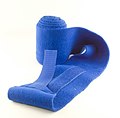bandage
Bandages ( protective, support bandages ) or Faschen (Austrian) are mostly soft, elastic pieces of fabric that are used to wrap injured parts of the body to protect them from dirt. However, there are also so-called support bandages that are supposed to protect the joints from overuse. In sport, bandages are used to protect bones and joints.
Word origin
The foreign word was borrowed in the 18th century from the French bandage , which actually means "connection, union (of persons)" and even goes back to the French bande (compare bande ). Fasche, on the other hand, comes from the Latin and Italian fascia (= band, ribbon; stripe).
Equestrian sport
In horses , bandages are used to protect the pastern and cannon bone . If it is used as protection, for example during transport or riding , it is essential to ensure that the bandage is correctly positioned. On the one hand, the bandages must not be wrapped too tightly, otherwise they impair the blood supply to the legs, but also not too loosely, as in this case they can easily come off and pose a risk of injury to horse and rider. An alternative are the less problematic gaiters .
Martial arts
In boxing wearing today is required by hand bandages for the fighter in the rules. Wearing hand or foot bandages is also widespread in other martial arts.
Bandages protect the bones and joints from sprains and fractures. In amateur boxing, the bandages must be made of cambric , gauze , tricot tube or flannel . Each bandage must be a maximum of 2.50 m long and 5 cm wide.
In ancient times, leather bandages were used. In addition to the protective effect, they should increase the risk of injury to the opponent. In Roman fistfights it is even said to have been permissible to occupy the bandages with metal plates.


